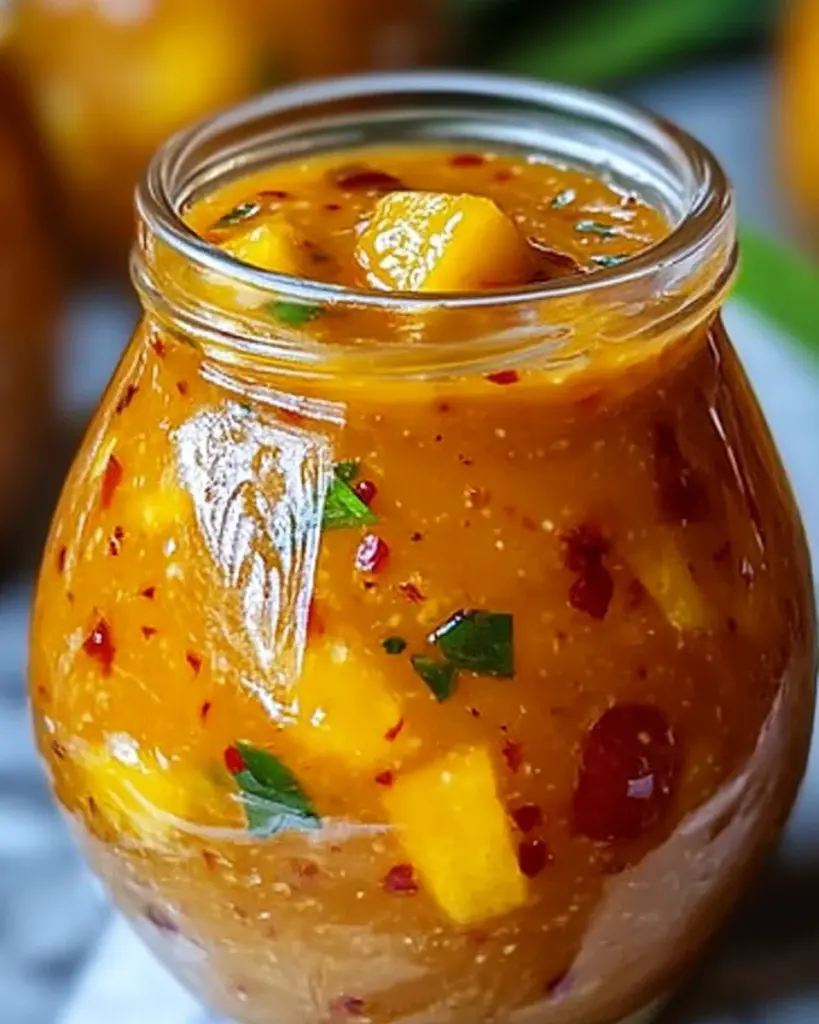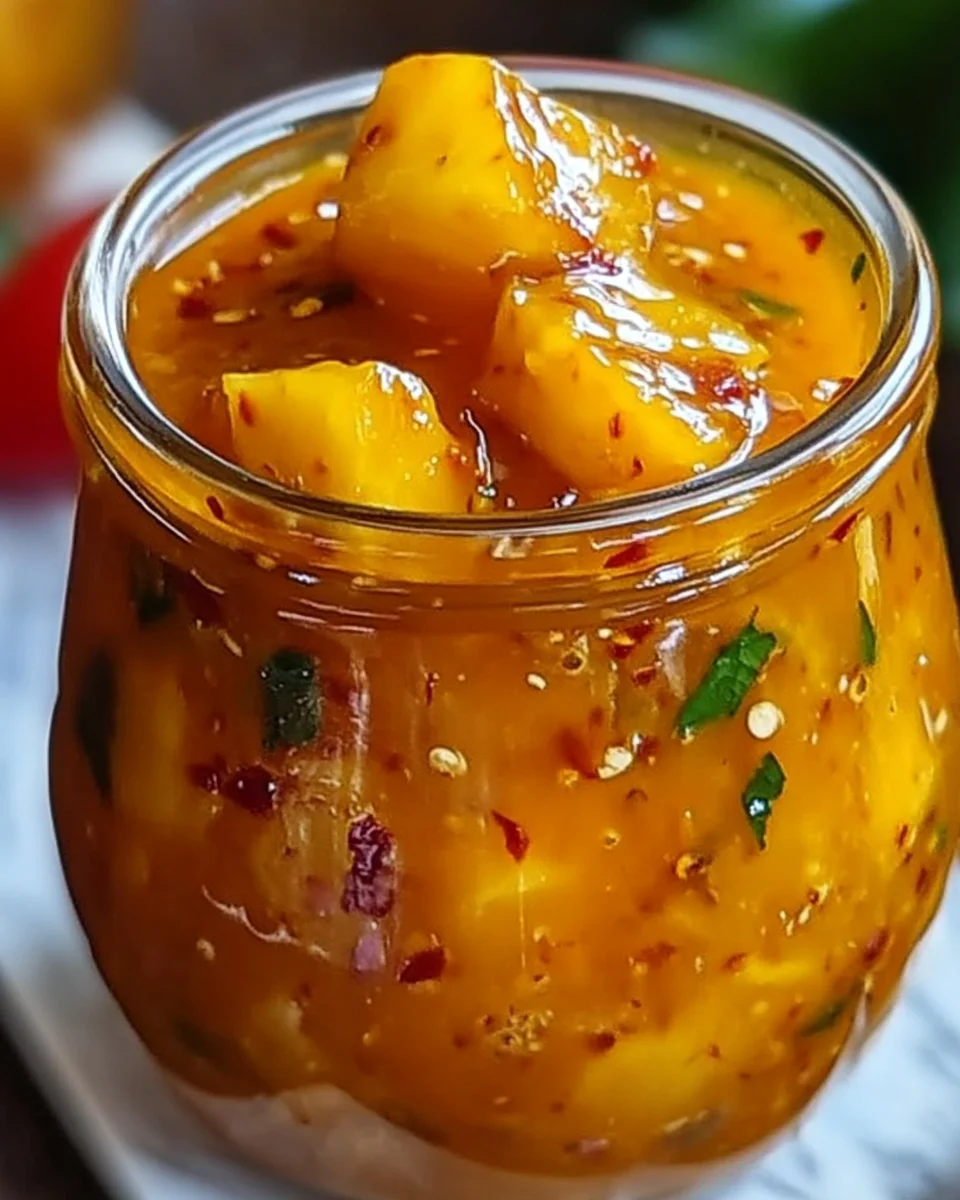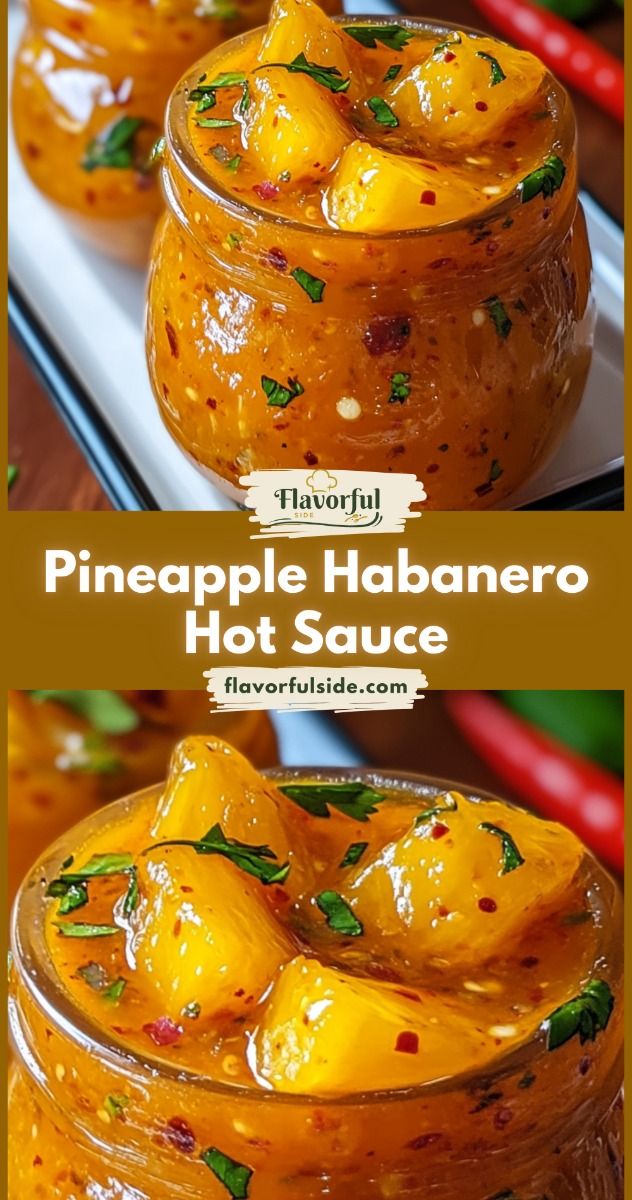Pineapple Habanero Hot Sauce is a delightful blend of sweet and fiery flavors that will elevate any dish. Perfect for tacos, grilled meats, seafood, or even scrambled eggs, this sauce brings a vibrant tropical twist to your meals. Its unique combination of ingredients makes it both bold and refreshing, making it suitable for casual gatherings or special occasions.

Why You’ll Love This Pineapple Habanero Hot Sauce
This hot sauce isn’t just about heat; it’s about flavor and versatility.
- Bold Flavor: The fusion of fresh pineapple and habanero peppers creates an exciting taste experience.
- Versatile Use: Great for tacos, BBQs, and dipping sauces, this sauce complements a variety of dishes.
- Easy to Make: With straightforward steps, you can whip up this delicious condiment in no time.
- Adjustable Heat Levels: By seeding the habaneros, you can tailor the heat to your preference.
- Long-lasting Freshness: Store it in the fridge for up to a month, ensuring you have a spicy kick on hand whenever you need it.
Tools and Preparation
Preparing your Pineapple Habanero Hot Sauce is simple with the right tools. Here’s what you’ll need.
Essential Tools and Equipment
- Medium saucepan
- Blender
- Fine-mesh sieve (optional)
- Sterilized bottle or jar
Importance of Each Tool
- Medium saucepan: Essential for cooking the aromatics and blending flavors together perfectly.
- Blender: This tool ensures a smooth consistency for your sauce, making it easy to pour over your favorite dishes.
- Fine-mesh sieve: Use this optional tool if you prefer an extra-smooth texture by straining out any chunky bits.
Ingredients
For this vibrant Pineapple Habanero Hot Sauce, gather the following ingredients:
Fresh Ingredients
- 2 cups fresh pineapple, chopped
- 4–6 habanero peppers, stemmed (seeded for less heat)
- ½ cup white onion, chopped
- 3 cloves garlic, peeled
Liquids and Seasoning
- ½ cup apple cider vinegar
- ¼ cup water
- 1 tbsp lime juice
- 1 tbsp honey, optional (for balance)
- 1 tsp salt
For Garnish
- 2 tablespoons fresh parsley, finely chopped

How to Make Pineapple Habanero Hot Sauce
Step 1: Sauté Aromatics
In a medium saucepan over medium heat, add a splash of oil. Sauté the chopped onion, garlic, and habaneros for about 3–4 minutes until fragrant and slightly softened.
Step 2: Add Fruit and Liquids
Stir in the chopped pineapple, apple cider vinegar, water, lime juice, honey (if using), and salt. Bring the mixture to a simmer.
Step 3: Simmer and Soften
Cook uncovered for 10–15 minutes until the pineapple is soft and the mixture reduces slightly in volume.
Step 4: Blend the Sauce
Carefully transfer the hot mixture to a blender. Blend until smooth. If necessary, add more water to adjust the consistency to your liking.
Step 5: Strain (Optional)
For a smoother finish, strain the sauce through a fine-mesh sieve into a bowl or container.
Step 6: Cool and Bottle
Allow the sauce to cool completely before transferring it to a sterilized bottle or jar. Store it in the refrigerator for up to one month. Enjoy your homemade Pineapple Habanero Hot Sauce!
How to Serve Pineapple Habanero Hot Sauce
Pineapple Habanero Hot Sauce is a versatile condiment that can elevate many dishes with its sweet, fiery flavor. Here are some delicious ways to enjoy this vibrant sauce.
Tacos
- Use Pineapple Habanero Hot Sauce as a topping for tacos to add a tropical twist that complements meats or vegetables perfectly.
Grilled Meats
- Drizzle the hot sauce over grilled chicken or pork for an exciting flavor boost that will impress your guests.
Seafood
- Pair the sauce with grilled fish or shrimp to enhance the natural sweetness of the seafood and add a spicy kick.
Scrambled Eggs
- Stir in a few drops of hot sauce into your scrambled eggs for breakfast, giving your morning meal a unique and zesty flair.
Nachos
- Add Pineapple Habanero Hot Sauce as a finishing touch on nachos, balancing the cheese and toppings with its sweet heat.
Dipping Sauce
- Serve it as a dipping sauce alongside fresh veggies or fried snacks like spring rolls for an exciting appetizer option.
How to Perfect Pineapple Habanero Hot Sauce
To achieve the best flavor and texture in your Pineapple Habanero Hot Sauce, consider these helpful tips.
- Choose ripe pineapple: A ripe pineapple will provide natural sweetness, enhancing the overall flavor of your hot sauce.
- Adjust heat levels: If you prefer less heat, remove the seeds from the habaneros before cooking. For more spice, leave them in.
- Experiment with sweetness: Adding honey is optional; adjust according to your taste preference. It balances out the heat beautifully.
- Allow it to cool completely: Letting the sauce cool before bottling ensures it thickens and develops its flavors fully.
- Store properly: Use sterilized bottles for storage to prolong freshness. Keep it in the refrigerator for up to one month.
- Blend thoroughly: For a smoother consistency, blend until completely smooth. This enhances its use as a condiment.

Best Side Dishes for Pineapple Habanero Hot Sauce
Pineapple Habanero Hot Sauce pairs wonderfully with various side dishes. Here are some tasty options that complement its bold flavor.
- Coconut Rice: Serve fluffy coconut rice alongside spicy dishes for a refreshing balance of flavors.
- Grilled Vegetables: Char-grilled veggies like zucchini and bell peppers enhance their sweetness when drizzled with hot sauce.
- Black Bean Salad: A cool black bean salad adds protein while providing a contrasting texture that pairs well with spicy sauce.
- Corn on the Cob: Grilled corn brushed with butter and topped with hot sauce makes for a fun and flavorful side.
- Potato Wedges: Crispy potato wedges tossed in olive oil and spices can be elevated by dipping them into this tangy hot sauce.
- Coleslaw: Creamy coleslaw offers crunch and creaminess that balances out the heat of the sauce beautifully.
Common Mistakes to Avoid
Making Pineapple Habanero Hot Sauce at home can be a delightful experience, but there are some common pitfalls to watch out for.
- Over-choosing peppers: Using too many habanero peppers can make the sauce overly spicy. Start with fewer and adjust to your heat preference.
- Ignoring ingredient freshness: Fresh ingredients yield the best flavor. Always use ripe pineapple and fresh habaneros for optimal taste.
- Skipping the simmering step: Not allowing the mixture to simmer can result in a less harmonious flavor. Take time to let it cook and meld together.
- Neglecting to strain: If you prefer a smoother sauce, skipping the straining step can leave you with an undesirable texture. Strain if smoothness is desired.
- Not cooling before bottling: Pouring hot sauce into bottles without cooling can cause condensation and spoilage. Always let it cool completely first.
Storage & Reheating Instructions
Refrigerator Storage
- Store in a sterilized bottle or jar.
- Keeps well for up to 1 month in the refrigerator.
Freezing Instructions
- Pour into ice cube trays or freezer-safe containers.
- Can be frozen for up to 6 months for long-term storage.
Reheating Instructions
- Oven: Preheat to 350°F (175°C) and warm in an oven-safe dish until heated through.
- Microwave: Heat in a microwave-safe container in short bursts, stirring in between until warmed.
- Stovetop: Gently warm over low heat in a saucepan, stirring frequently to avoid burning.

Frequently Asked Questions
What is Pineapple Habanero Hot Sauce?
Pineapple Habanero Hot Sauce is a sweet, spicy condiment that combines fresh pineapple with fiery habanero peppers, perfect for adding tropical heat to various dishes.
How long does Pineapple Habanero Hot Sauce last?
When stored properly in the refrigerator, this hot sauce can last up to one month. For longer storage, consider freezing it.
Can I adjust the heat level of Pineapple Habanero Hot Sauce?
Yes! You can control the heat by using fewer habaneros or removing the seeds from them. Adjust according to your spice tolerance.
What dishes pair well with Pineapple Habanero Hot Sauce?
This sauce complements tacos, grilled meats, seafood, and even scrambled eggs. Its vibrant flavor adds excitement to any meal.
Final Thoughts
Pineapple Habanero Hot Sauce is not just a condiment; it’s an explosion of flavor that enhances many dishes. Feel free to customize it by adjusting the sweetness or spiciness according to your taste preferences. Enjoy experimenting with this vibrant sauce!
Want to keep track of it? Pin this Pineapple Habanero Hot Sauce recipe on Pinterest and share your creations in the comments!


Pineapple Habanero Hot Sauce
- Total Time: 30 minutes
- Yield: Approximately 16 servings 1x
Description
Pineapple Habanero Hot Sauce is a tantalizing blend of sweet and spicy, perfect for adding a vibrant kick to your meals. This versatile condiment combines the tropical sweetness of fresh pineapple with the fiery heat of habanero peppers, creating an exciting flavor profile that enhances everything from tacos to grilled meats. Easy to prepare and customizable to your preferred heat level, this homemade hot sauce is ideal for casual gatherings or special occasions. Whether drizzled on seafood, mixed into scrambled eggs, or used as a dipping sauce, this Pineapple Habanero Hot Sauce will elevate your dishes and impress your guests.
Ingredients
- 2 cups fresh pineapple, chopped
- 4–6 habanero peppers, stemmed (seeded for less heat)
- ½ cup white onion, chopped
- 3 cloves garlic, peeled
- ½ cup apple cider vinegar
- ¼ cup water
- 1 tbsp lime juice
- 1 tbsp honey (optional)
- 1 tsp salt
Instructions
- In a medium saucepan over medium heat, sauté the onion, garlic, and habaneros in a splash of oil for about 3–4 minutes until fragrant.
- Add the chopped pineapple, apple cider vinegar, water, lime juice, honey (if using), and salt. Bring to a simmer.
- Cook uncovered for 10–15 minutes until the pineapple softens and the mixture reduces slightly.
- Carefully transfer the mixture to a blender and blend until smooth. Adjust with more water if needed.
- (Optional) Strain through a fine-mesh sieve for a smoother texture.
- Allow the sauce to cool completely before transferring it to a sterilized bottle or jar. Store in the refrigerator for up to one month.
- Prep Time: 10 minutes
- Cook Time: 20 minutes
- Category: Sides
- Method: Cooking
- Cuisine: Tropical
Nutrition
- Serving Size: 1 tablespoon
- Calories: 10
- Sugar: 1g
- Sodium: 115mg
- Fat: 0g
- Saturated Fat: 0g
- Unsaturated Fat: 0g
- Trans Fat: 0g
- Carbohydrates: 2g
- Fiber: <1g
- Protein: <1g
- Cholesterol: 0mg


Leave a Comment